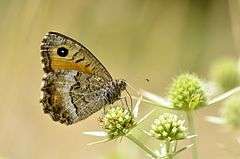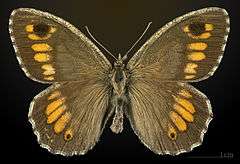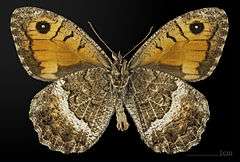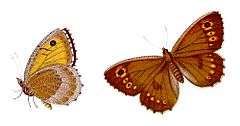Arethusana
| Arethusana | |
|---|---|
| Arethusana arethusa, underside | |
| Scientific classification | |
| Kingdom: | Animalia |
| Phylum: | Arthropoda |
| Class: | Insecta |
| Order: | Lepidoptera |
| Family: | Nymphalidae |
| Subfamily: | Satyrinae |
| Genus: | Arethusana de Lesse, 1951 |
| Species: | A. arethusa |
| Binomial name | |
| Arethusana arethusa (Schiffermüller, 1775) | |
| Synonyms | |
| |
Arethusana is a butterfly genus from the subfamily Satyrinae of the brush-footed butterfly family (Nymphalidae). It is composed of only one species, Arethusana arethusa, the false grayling
Subspecies
Subspecies include:[1]
- Arethusana arethusa aksouali Wyatt, 1952 (western Morocco: Toubkal Massif)
- Arethusana arethusa arethusa
- Arethusana arethusa heptapotamica (Stauder, 1924) (Tian Shan, Dzhungarsky Alatau, Saur, Tarbagatai)
- Arethusana arethusa pontica (Heyne, [1895]) (Caucasus, Armenian Highland)
- Arethusana arethusa boabdil (Rambur, 1895) (Granda, Andalusia – Spain)
- Arethusana arethusa dentata (Staudinger, 1871) (Catalonia – Spain)
The subspecies Arethusana arethusa boabdil and Arethusana arethusa dentata are considered as full species by some authors.[2]
Description

Arethusana arethusa has a wingspan of 42–47 millimetres (1.7–1.9 in) in males, of 50–54 millimetres (2.0–2.1 in) in females.[3] The length of the forewings can reach 21–25 mm.[4] The upper surface of the wings is dark brown, with a characteristic series of ocher-orange oval markings forming a V and a blackish brown large spot close to the top of the forewings. Also the hindwings have a small blackish spot near the border. The external edges of the wings has a tooth-shaped pattern. The underside of the hindwings is mottled and shows a transversal whitish band dividing the wing and well marked white veins.[5]
This species is rather similar to Pseudochazara graeca and Pseudochazara orestes.
Distribution and habitat
This species can be found as far west as Morocco and as far eastward as south-west Siberia and northern Tian Shan.[1] These butterflies prefer grassy and bushy areas, steppes and arid sparse woodlands, at an elevation of 0–2,500 metres (0–8,202 ft) above sea level.[2][4][6]
Biology
This species is univoltine. The caterpillars overwinter in the first larval instar. The larvae feed on various grasses, including Festuca, Bromus erectus, Brachypodium pinnatum, Cynosurus cristatus, Corynephorus canescens, Dactylis and Poa species.[1] Adults are on wing from July to September.[2]
Gallery
 Male, dorsal view
Male, dorsal view Ventral view
Ventral view Illustration
Illustration
External links
| Wikimedia Commons has media related to Arethusana. |
| Wikispecies has information related to Arethusana |
- Vlindernet (in Dutch)
- Paolo Mazzei, Daniel Morel, Raniero Panfili Moths and Butterflies of Europe and North Africa
- Lepiforum.de
References
- 1 2 3 Arethusana at Markku Savela's Lepidoptera and Some Other Life Forms
- 1 2 3 Satyrinae of the Western Palearctic - Arethusana arethusa
- ↑ UK Butterflies
- 1 2 Captain's European Butterfly Guide
- ↑ Euro Butterflies by Matt Rowlings
- ↑ Fauna europaea